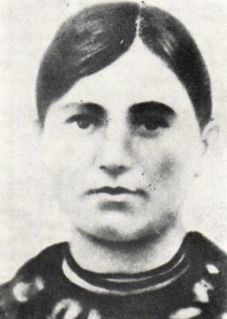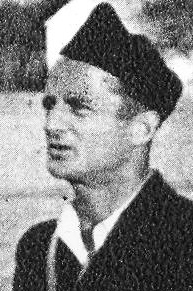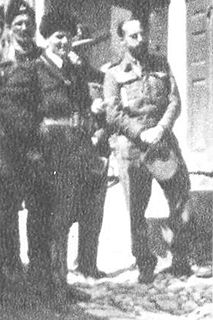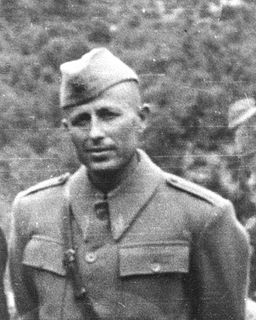The Anti-Fascist Council for the National Liberation of Yugoslavia commonly abbreviated as the AVNOJ, was a deliberative and legislative body that was established in Bihać, Yugoslavia, in November 1942. It was established on the instigation of Josip Broz Tito, the leader of the Yugoslav Partisans – an armed resistance movement led by the Communist Party of Yugoslavia to resist the Axis occupation of the country during World War II.

The Yugoslav Partisans, or the National Liberation Army, officially the National Liberation Army and Partisan Detachments of Yugoslavia, was the Communist-led Anti-fascist resistance to the Axis powers in occupied Yugoslavia during World War II. Led by Josip Broz Tito, the Partisans are considered to be Europe's most effective anti-Axis resistance movement during World War II.
The State Anti-Fascist Council for the National Liberation of Croatia, commonly abbreviated ZAVNOH, was first convened on 13–14 June 1943 in Otočac and Plitvice as the chief political representative body in World War II Axis-occupied Croatia. It was dominated by the Communist Party of Croatia, a nominally-independent political party active in the territory largely corresponding to present-day Croatia. Despite its nominal independence, the party was a de facto branch of the Josip Broz Tito-led Communist Party of Yugoslavia. ZAVNOH also included representatives or former members of peasant organisations, trade unions, the Croatian Peasant Party, and the Independent Democratic Party.

Operation Uzice was the first major counter-insurgency operation by the German Wehrmacht on the occupied territory of the Kingdom of Yugoslavia during World War II. The operation was directed against the Užice Republic, the first of several "free territories" liberated by the Yugoslav Partisans. It was named after the town of Užice, and is associated with the First Enemy Offensive in Yugoslavian historiography. The security forces of the German-installed puppet regime of Milan Nedić also participated in the offensive.

Operation Trio was the first large-scale joint German-Italian counter-insurgency operation of World War II conducted in the Independent State of Croatia (NDH), which included modern-day Bosnia and Herzegovina. It was carried out in two phases within eastern Bosnia from 20 April to 13 May 1942, with Ustaše militia and Croatian Home Guard forces taking part on the Axis side. The aim of the operation was to target all insurgents between Sarajevo and the Drina river in eastern Bosnia. These included the communist-led Yugoslav Partisans and Serb nationalist Chetniks. Differentiating between the rank and file of the two insurgent factions was difficult, as even the communist-led insurgent groups consisted mainly of Serb peasants who had little understanding of the political aims of their leaders.

Marija Bursać was a member of the Yugoslav Partisans during World War II in Yugoslavia and the first woman proclaimed a People's Hero of Yugoslavia. Bursać was born to a Bosnian Serb farming family in the village of Kamenica, near Drvar. After the invasion of Yugoslavia by the Axis powers and their creation of the Independent State of Croatia in April 1941, Bursać supported the Partisan resistance movement led by the Communist Party of Yugoslavia (KPJ). Like other women in her village, she collected food, clothing, and other supplies for the Partisan war effort. Bursać became a member of the League of Communist Youth of Yugoslavia in September 1941. The following August she was appointed political commissar of a company of the 1st Krajina Agricultural Shock Brigade, which harvested crops in the Sanica River valley, and was admitted to the KPJ at the end of that summer.
Ljubo Novaković was a Montenegrin officer in the Royal Yugoslav Army who became a Chetnik commander during World War II. He initially fought for the Chetniks of Draža Mihailović and those of Kosta Pećanac, but became disillusioned with both movements. He went to eastern Bosnia in late 1941, and raised Chetnik bands to fight Yugoslav Partisans there. He was captured by the Partisans in January 1942 and taken to Foča, where he was kept under constant surveillance. Partisan leader Josip Broz Tito likely believed that Novaković could be used to counteract Mihailović's influence among Chetniks in eastern Bosnia. Novaković left Foča with a British mission in April 1942 and returned to Montenegro with the intention of reassembling the disorganized Chetnik formations there. He was killed in late 1943, either by the Partisans or Mihailović's Chetniks.

The Yugoslav volunteers in the Spanish Civil War, known as Spanish fighters and Yugoslav brigadistas, was a contingent of volunteers from the Kingdom of Yugoslavia that fought for the Republicana during the Spanish Civil War (1936–1939). An estimated 1,664 "Yugoslav brigadistas" fought in the war, out of whom c. 800 were killed in action. According to Spanish statistics, 148 Yugoslav volunteers received the officer rank during the conflict.

Lieutenant Colonel Zaharije Ostojić was a Montenegrin Serb and Yugoslav military officer who served as the chief of the operational, organisational and intelligence branches of the Chetnik Supreme Command led by Draža Mihailović in Yugoslavia during World War II. He was a major in the Royal Yugoslav Army Air Force prior to the Axis invasion of Yugoslavia, and was involved in the coup that deposed Prince Paul of Yugoslavia on 27 March 1941. After the coup, he escorted Prince Paul to exile in Greece, and was in Cairo during the invasion in April. In September 1941, he was landed on the coast of the Italian governorate of Montenegro along with the British Special Operations Executive officer Captain Bill Hudson and two companions. He escorted Hudson to the German-occupied territory of Serbia and introduced him to the Yugoslav Partisan leader Josip Broz Tito at Užice, then accompanied Hudson to Ravna Gora to meet Mihailović. Ostojić soon became Mihailović's chief of staff, and after the German attempt to capture the Chetnik leader during Operation Mihailovic in December 1941, brought the Chetnik Supreme Command staff to Montenegro where they were re-united with Mihailović in June 1942. During the remainder of 1942, Ostojić launched a counter-attack against Ustaše troops of the Independent State of Croatia returning to the eastern Bosnian town of Foča where they were expected to continue their genocidal anti-Serb policies. As many as 2,000 local Muslims were subsequently killed in the town by forces under Ostojić's command. Ostojić later oversaw large-scale massacres of civilians and burning of Muslim villages in the border region between Montenegro and the Sandžak.

The Battle of Pljevlja, was a World War II attack in the state of Montenegro by partisans on Italian military forces occupying the city of Pljevlja under the command of General Arso Jovanović and Colonel Bajo Sekulić, who led 4,000 Montenegrin Partisans.

The German–Yugoslav Partisan negotiations were held between German commanders in the Independent State of Croatia and the Supreme Headquarters of the Yugoslav Partisans in March 1943 during World War II. The negotiations – focused on obtaining a ceasefire and establishing a prisoner exchange – were conducted during the Axis Case White offensive. They were used by the Partisans to delay the Axis forces while the Partisans crossed the Neretva River, and to allow the Partisans to focus on attacking their Chetnik rivals led by Draža Mihailović. The negotiations were accompanied by an informal ceasefire that lasted about six weeks before being called off on orders from Adolf Hitler. The short-term advantage gained by the Partisans through the negotiations was lost when the Axis Case Black offensive was launched in mid-May 1943. Prisoner exchanges, which had been occurring between the Germans and Partisans for some months prior, re-commenced in late 1943 and continued until the end of the war.

Vicko Krstulović was a Yugoslav communist revolutionary, the most prominent Partisan military commander from Dalmatia during World War II, and a post-war communist politician. He was an illegal communist activist during the 1920s and 1930s in Split at a time when communist sympathizers were brutally persecuted by the Yugoslav monarchy. As an officer in the Partisans during World War II, he was in charge of creating and organising the resistance movement in Dalmatia. In Socialist Yugoslavia, he worked in various government offices and was remembered for his work and contribution to his native Split.
Rudolf Perhinek was Yugoslav military officer with the rank of Captain in the Royal Yugoslav Army who, soon after the Axis invasion of Yugoslavia, joined Chetniks of Dragoslav Mihailović. He was a member of the Supreme Command of Mihailović's Chetniks and received the rank of Major. Perhinek, also referred as Mihailović's right hand, organized Chetniks in Montenegro at the end of 1941. In period October 1941 — September 1943 he was a special envoy of Mihailovic's Chetnik staff for Montenegro who was also responsible for the intelligence service in Montenegro and Albania. Some sources describe him as an agent of Gestapo. For some time he was the Chief of Staff of Chetnik forces under command of Vojislav Lukačević. Perhinek was an ethnic Slovene. Yugoslav Government in Exile awarded him with Order of the Star of Karađorđe.

The Partisan Long March was the redeployment of Josip Broz Tito's Partisan Supreme Headquarters and the major fighting elements of the Yugoslav Partisans across the Independent State of Croatia, from south-eastern to north-western Bosnia that commenced in late June 1942. The march followed the first large-scale joint German-Italian counter-insurgency operation in the NDH, Operation Trio, and the combined Italian-Montenegrin Chetnik offensive in Montenegro and eastern Herzegovina.
Boško Todorović was a Chetnik commander and delegate of the Chetnik leader Draža Mihailović in eastern Bosnia during World War II. During the interwar period he was a major in the Royal Yugoslav Army. Following the April 1941 Axis invasion of Yugoslavia he joined Mihailović's Chetnik movement. Initially considered a moderate, he was responsible for negotiating the transfer of parts of eastern Bosnia from Italian to Chetnik administration in November 1941, after which the Chetniks massacred hundreds of Muslim civilians in the region. He also signed a collaboration agreement with the Italians to protect the Serb population in Italian-occupied areas. He was killed by the Yugoslav Partisans in February 1942, either trying to evade capture, or he was executed after a brief trial when captured in possession of compromising documents regarding collaboration with the Italians.

Terence Atherton (1902–1942) was a British journalist and a British Special Operations Executive intelligence officer during World War II.

The Croatian Partisans, officially the National Liberation Movement in Croatia, were part of the anti-fascist National Liberational Movement in the Axis-occupied Yugoslavia which was the most effective anti-Nazi resistance movement led by Yugoslav revolutionary communists during the Second World War. NOP was under the leadership of the League of Communists of Yugoslavia (KPJ) and supported by many others, with Croatian Peasant Party members contributing to it significantly. NOP units were able to temporarily or permanently liberate large parts of Croatia from occupying forces. Based on the NOP, the Federal Republic of Croatia, which was referred to by Winston Churchill as "the Croatian miracle" was founded as a constituent of the Democratic Federal Yugoslavia.

Mitar Bakić, was a Yugoslav politician, general and People's Hero of Yugoslavia. During World War II, he was political commissar of the 4th Montenegrin brigade, 2nd Proletarian Division and 2nd Corps. After the war, he was the chief of staff of Josip Broz Tito, secretary-general of the Yugoslav government and member of Yugoslav mission in United Nations. He also had rank of reserve lieutenant general of Yugoslav People's Army.

Stolice conference was a military-political conference of the leadership of the Yugoslav Partisans, held on 26 September 1941 in the village of Stolice, near Krupanj in present-day Serbia. The conference was led by the general secretary of the Communist Party of Yugoslavia and the commander of the Chief Headquarters Josip Broz Tito. It was attended by representatives of military and party leaders from Serbia, Croatia, Slovenia, Bosnia and Herzegovina and commanders of the nearest partisan detachments from Serbia.
![Tito (far right) and members of the Supreme Headquarters in front of the Tito's cave [sr] in Drvar on 14 May 1944, days before Operation Rosselsprung. Marshal Tito during the Second World War in Yugoslavia, May 1944.jpg](http://upload.wikimedia.org/wikipedia/commons/thumb/5/54/Marshal_Tito_during_the_Second_World_War_in_Yugoslavia%2C_May_1944.jpg/330px-Marshal_Tito_during_the_Second_World_War_in_Yugoslavia%2C_May_1944.jpg)













